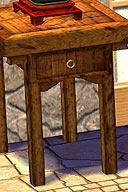The Sims Forever!The Sims lives on! What's New in The Sims 2The Sims 2 Stories Relationships Activities Life cycles Get into the scene Lighting and graphics Building better buildings System requirements Testing Cheats New Challenges for ArtistsSkinning Animations Tools for artists The Sims 2 on the Net |

major credit cards
through our secure server.

3D Graphics in The Sims 2
Textures provide additional dimension

Here's a closer view of one of the bedside tables in the illustration on page 1.
Calculating 3D surfaces takes a lot of CPU time, so in video games we keep the number of faces in each object to a minimum and depend on shading to provide additional surface features.
We can model a little table like this with some basic blocks -- the legs, the body of the table, the table top, and a couple of extra blocks for the little bits that stick out at from the body of the table beneath the top. Lighting effects provide the major highlights and shadows. All else is done with shading in the texture.
The drawer and its pull are just part of the texture image that gets mapped onto the front of the table body. The woodgrain and darker stains at the edges of the legs come from the texture. So do the inlaid blocks on the table top and the individual boards at the front of the drawer.
Similarly, the wall and floor are flat planes with a texture painted onto them, although both this wall and floor show a very rich three-dimensional surfaces made up of pieces of stone.
When we do this we take advantage of the way the human mind perceives things to exercise a bit of license in the shading of the texture.
Note the shadow of the table leg on the floor. You can see that the light is coming from behind the viewer, high and to the left. Now look at the shadows of the stones in the wall -- for them, the light appears to be coming from the ceiling.
The discrepancy is so trivial that you never would have noticed it if we hadn't shoved it in front of your nose. Your mind perceives the wall as a stone wall and pushes it into the background as an attractive but unimportant part of the scene, so the viewer will never see these little oddities of lighting.

